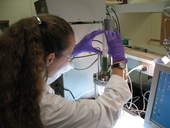Highlight
Computer science helps augment hydrogen energy
Achievement/Results
An interdisciplinary team of NSF-sponsored researchers at Oregon State University have obtained substantial increases in the production of hydrogen from cyanobacteria, making a step toward the creation of a “green” hydrogen economy. To achieve a global hydrogen economy, a cost-effective, renewable method for hydrogen (H2) production must be developed. This H2 would primarily be used in fuel cells, which can achieve efficiencies up to 80%.
Currently, about 95% of commercial H2 is produced by steam reforming of natural gas, which is energy intensive, produces CO2, and depends on a nonrenewable energy carrier. As an alternative, many species of cyanobacteria and green algae can use solar energy to split water and produce H2 naturally at ambient temperatures. Since photosynthetic microorganisms split water, and fuel cells reverse that process by resynthesizing water from H2 and O2, a closed-loop energy generation system is created. Various combinations of environmental conditions and nutrient levels can bring about higher cyanobacterial H2 production, and currently researchers are attempting to identify optimum conditions in order to help biosolar H2 become commercially viable.
Liz Burrows, a PhD trainee in the Ecosystem Informatics IGERT (Interdisciplinary Graduate Education and Research Training) program at OSU and her advisors Roger Ely and Frank Chaplen in Biological and Ecological Engineering collaborated with computer scientists Weng-Keen Wong and Xiaoli Fern in the School of Electrical Engineering and Computer Science at OSU to apply an optimization algorithm that showed several distinct advantages over the standard optimization method used in biotechnology. Combining both optimization methods, Liz was able to obtain on the order of 1200 times more H2 compared to standard cell culturing methods. Her work also demonstrated that optima were able to be located and that low nutrients, rather than the well-studied total nutrient deprivation, was far superior for H2 production as well as for cell growth, indicating potential for long-term H2 production. Liz used her background in mathematics, environmental science and engineering combined with her skills in interdisciplinary collaboration gained through the IGERT training program to help bridge the gap between theoretical and experimental optimization, and to progress from purely physiological studies toward application. Liz is continuing this line of research as a postdoctoral research associate in the Dismukes lab in the chemistry department at Princeton.
Address Goals
By fostering interdisciplinary research linking bio-engineering, computer science, and ecology, the Ecosystem Informatics IGERT program helped the student (Liz Burrows) and her collaborators (Ely, Chaplen, Wong) advanced the frontiers of knowledge in green energy – specifically hydrogen production. Hydrogen energy is one of the areas of greatest opportunity and potential benefit for the United States to achieve sustainable energy production, and this research contributes to making the US a global leader in fundamental transformational science and engineering in the area of green energy.
The interdisciplinary team included a woman engineer (the student, Liz Burrows), and an Asian computer scientist (Wong), thus contributing to the NSF goals to cultivate a world-class, broadly inclusive science and engineering workforce. The teams’ multiple presentations in scientific and outreach settings promoted understanding of the links among engineering, ecology, and computer science for energy production, and expanded the scientific literacy of all citizens.







